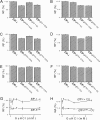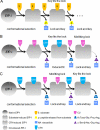Substrate-induced changes in protease active site conformation impact on subsequent reactions with substrates
- PMID: 20484054
- PMCID: PMC2906288
- DOI: 10.1074/jbc.M110.103549
Substrate-induced changes in protease active site conformation impact on subsequent reactions with substrates
Abstract
Enzymatic catalysis of biochemical reactions is essential to all living systems. The "lock and key" and "induced fit" models were early contributions to our understanding of the mechanisms involved in the reaction between an enzyme and its substrate. However, whether a given substrate-induced conformation is rigid or remains flexible has not yet been determined. By measuring the enzyme activity and intrinsic fluorescence of a nonspecific Eisenia fetida protease-I with different chromogenic substrates, we show that in subsequent reactions of protease with substrates, both the "lock and key" and "induced fit" mechanisms are used depending on the degree of conformational change required. Chromozym-Th- or chromosym-Ch-induced protease conformations were unable to bind chromozym-U. The chromosym-U-induced protease conformation remained flexible and could be further induced by chromozym-Th and chromozym-Ch. When low concentrations of guanidine HCl were used to disturb the conformation of the enzyme, only small changes in intrinsic fluorescence of the chromozym-Th-induced protease were detected, in contrast to the native enzyme whose intrinsic fluorescence markedly increased. This indicates that the substrate-induced enzyme was relatively rigid compared with the native protease. Utilizing a lock and key mechanism for secondary substrate reactions may have adaptive value in that it facilitates high efficiency in enzymatic reactions.
Figures






Similar articles
-
In situ localization and substrate specificity of earthworm protease-II and protease-III-1 from Eisenia fetida.Int J Biol Macromol. 2007 Jan 30;40(2):67-75. doi: 10.1016/j.ijbiomac.2006.05.007. Epub 2006 May 26. Int J Biol Macromol. 2007. PMID: 16814856
-
Earthworm protease in anti-thrombosis and anti-fibrosis.Biochim Biophys Acta Gen Subj. 2019 Feb;1863(2):379-383. doi: 10.1016/j.bbagen.2018.11.006. Epub 2018 Nov 13. Biochim Biophys Acta Gen Subj. 2019. PMID: 30445042 Review.
-
Serine protease specificity for peptide chromogenic substrates.Thromb Haemost. 1977 Dec 15;38(4):776-92. Thromb Haemost. 1977. PMID: 146272
-
Hydrolysis of fibrinogen and plasminogen by immobilized earthworm fibrinolytic enzyme II from Eisenia fetida.Int J Biol Macromol. 2003 Sep;32(3-5):165-71. doi: 10.1016/s0141-8130(03)00050-3. Int J Biol Macromol. 2003. PMID: 12957313
-
Detection of protease activity in cells and animals.Biochim Biophys Acta. 2016 Jan;1864(1):130-42. doi: 10.1016/j.bbapap.2015.04.029. Epub 2015 May 7. Biochim Biophys Acta. 2016. PMID: 25960278 Review.
Cited by
-
Co-factor binding confers substrate specificity to xylose reductase from Debaryomyces hansenii.PLoS One. 2012;7(9):e45525. doi: 10.1371/journal.pone.0045525. Epub 2012 Sep 26. PLoS One. 2012. PMID: 23049810 Free PMC article.
-
Manipulating protein conformations by single-molecule AFM-FRET nanoscopy.ACS Nano. 2012 Feb 28;6(2):1221-9. doi: 10.1021/nn2038669. Epub 2012 Feb 1. ACS Nano. 2012. PMID: 22276737 Free PMC article.
References
Publication types
MeSH terms
Substances
LinkOut - more resources
Full Text Sources

